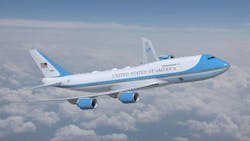Boeing moves forward on VC-25B jets, avionics, and secure communications to serve as new Air Force One
WRIGHT-PATTERSON AFB, Ohio – Aircraft designers at the Boeing Co. are beginning design and production of the latest models of the Air Force One presidential aircraft under terms of a $69.1 million order announced late last month.
Officials of the U.S. Air Force Life Cycle Management Center at Wright Patterson Air Force Base, Ohio, are asking the Boeing Defense, Space & Security segment in Tukwila, Wash., for long-lead spart parts for two VC-25B presidential aircraft.
These aircraft are follow-on versions of the Boeing VC-25A aircraft, which have been in service since 1990. The Boeing VC-25 is a military version of the Boeing 747 airliner, modified for presidential transport and commonly operated by the Air Force as Air Force One.
Long-lead spare parts either are difficult and time-consuming to obtain, and are funded early in the aircraft design process to keep overall production on schedule. Contracts to build the two VC-25B aircraft will come later.
The VC-25A will be based on the Boeing 747-8 Intercontinental, which first flew in 2025. Boeing is modifying two existing 747-8I aircraft, which will become the VC-25Bs, and are to replace the two aging VC-25As. The VC-25A is based on the Boeing 747-200B.
The VC-25B will have three primary differences from the current VC-25A: It will use a lighter shade of blue; its engines will be painted darker blue than the VC-25A's robin's egg blue; and the VC-25B will have no polished metal section because modern commercial aircraft skin alloys do not allow for it.
The primary mission of the VC-25 is to provide air transport for the president of the United States. The aircraft has special avionics and communications equipment, self-contained baggage loader, front and aft air-stairs, and the capability for in-flight refueling.
The onboard electronics are hardened to protect against an electromagnetic pulse, and Air Force One is equipped with advanced secure communications equipment to enable the aircraft to be a mobile command center in the event of an attack on the United States.
Related: Air Force asks Boeing for prototype avionics for upgrade of Air Force One aircraft
The Air Force One aircraft has a stateroom with dressing room, lavatory, and shower, as well as the president's office. It has a conference and dining room, and two galleys for meal preparation. The first VC-25B flight is scheduled for March 2026.
The VC-25 has four General Electric CF6-80C2B1 jet engines. The aircraft is nearly 232 feet long, 64 feet high, and has a 196-foot wingspan. It can fly as fast as 630 miles per hour at altitudes to 45,100 feet.
On this order Boeing will do the work in San Antonio, Texas, and should be finished by January 2028. For more information contact Boeing Defense, Space & Security online at https://www.boeing.com/defense/air-force-one, or the Air Force Life Cycle Management Center at https://www.aflcmc.af.mil.
About the Author
John Keller
Editor-in-Chief
John Keller is the Editor-in-Chief, Military & Aerospace Electronics Magazine--provides extensive coverage and analysis of enabling electronics and optoelectronic technologies in military, space and commercial aviation applications. John has been a member of the Military & Aerospace Electronics staff since 1989 and chief editor since 1995.
